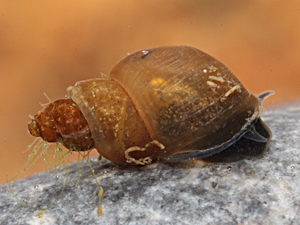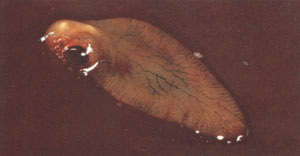
Small pond snail or liver fluke snail (Galba truncatula).
Picture: © Alexander Mrkvicka, Wien (mrkvicka.at).
 Small pond snail or liver fluke snail (Galba truncatula). Picture: © Alexander Mrkvicka, Wien (mrkvicka.at). |
![]() additional
information on the generation cycle
of Fasciola hepatica.
additional
information on the generation cycle
of Fasciola hepatica.
The larger liver fluke's intermediate host, however, is a water snail, Galba truncatula, a pond snail (Lymnaeidae).
The liver fluke's larva hatched from their eggs in the water they infect pond snails (Galba truncatula). This snail has got a yellow-brown shell, the whorls of which are set against each other like stairs.
 |
Inside the snails the miracidia live on nutrients from the snail's blood and reproduce parthenogenetically. Having reached a sufficient number, they leave the snail through its skin and in the water change into the next larval generation, the cercariae. Those produce endurance stages (cysts) on plants standing near the water. In this stage they can endure several weeks even if they fall dry.
Mammals grazing near the mentioned water may be infected by the cercariae, as soon as the cysts' walls are digested. From the terminal host's digestive tract the cercariae move into the liver where they change into adult liver flukes. Those reproduce sexually and afterwards lay eggs. The host animal excretes the eggs into the water, where the miracidia can hatch, the generation cycle is closed.
The larger liver fluke especially is distributed where cattle graze on meadows near the water. Pond snails due to their partly amphibious way of living can survive their home water falling dry remaining dug in the mud.